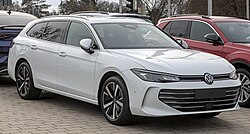D-segment2020 Best-Selling BMW 3 Series 7th generation (2018–present) Volkswagen Passat 8th generation (2015–2024) The D-segment is the 4th category of the European segments for passenger cars, and is described as "large cars".[1][2] It is equivalent to the Euro NCAP "large family car" size class,[3] and the present-day definition of the mid-size car category used in North America.[4][5] Compact executive cars are part of the D-segment size category. D-segment sales represented about 7% of the market in the 2010s.[6][7] CharacteristicsMost D-segment cars are sedans/saloons or wagons/estates but hatchbacks, and coupes have been common. Pricing and specification of D-segment cars can vary greatly, from basic low-cost transport to more luxurious and expensive models. As of 2021 the typical D-segment category size ranges from about 4.6 to 4.8 m (15.1 to 15.7 ft). Current modelsD-segment cars in Europe are the BMW 3 Series, Mercedes-Benz C-Class, Audi A4/S4/RS4, Mazda6, Škoda Superb, Volvo S60/V60, Jaguar XE, Citroën C5, Peugeot 508, Audi A5/S5/RS5, BMW 4 Series, Volkswagen Arteon, Honda Accord, Toyota Camry and Polestar 2. [8] 100,000 – 200,000 sales (Best-Selling)
50,000 – 100,000 sales
10,000 – 50,000 sales
List of current cars produced in 2024
Sales figures in Europe
Notes: Jump in segment total sales after 2019. year is because premium cars are included. From 2014 to 2018 premium cars are not included in total segment sales. Premium brands and models are marked italic. Electric cars are included in D-segment from 2019. year. Market share in Europe2019 - After years of decline, the midsized car segment is actually up 1% in 2019 to 1.05 million sales, maintaining a 6.7% share of the overall car market. [6] 2020 - The midsized car segment is down 25% in 2020 to just under 790,000 sales, as its share of the European car market drops to 6.6%, slightly down from 6.7% last year. And luxury brands have now officially taken over control of this class, improving their share to 62.3% from 60.5% last year and claiming four of the top-5 positions. The top-3 players all gain share, outperforming not only the class but also the overall market. [7] Historic modelsNote: this list includes cars from these decades which carried a different nameplate or numeric designation to the modern day equivalent, and in some cases there is no modern day direct equivalent 1960s
1970s
1980s
1990s
2000s
2010s
2020s
See alsoReferences
|
Portal di Ensiklopedia Dunia


























